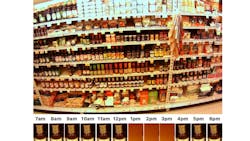Vision System at Walmart Canada Tracks Inventory on Store Shelves
Walmart Canada is rolling out an automated vision system to keep store shelves stocked with merchandise.
The announcement follows the megaretailer’s 70-store pilot project using a computer vision solution from Focal Systems (Burlingame, CA, USA; www.focal.systems). The product uses a combination of cameras and AI-based software to automate out-of-stock detection.
In a news release, Robin DeMers, Director, Store Optimization at Walmart (Mississauga, Ontario, Canada; www.walmart.ca/en) says Walmart purchased the technology to improve the shopping experience for customers and the working experience for employees. “We know it can be disappointing for customers when we don’t have products they want available on our shelves. That’s why we initiated this pilot using technology from Focal Systems that takes the guesswork out of knowing when a product is out of stock,” she explains. “This leading-edge technology provides real-time, automated alerts for replenishment in key priority areas within our stores. It also empowers our associates with cool tech that makes a big difference in the way they are able to work and provide the best possible customer experience.”
There are four types of battery-operated, Wi-Fi-enabled cameras from Focal Systems, depending on whether they will be affixed to shelves, refrigerator units, peg-hooks and produce, or end-of-aisle units. A typical 30,000 square-foot store would use about 400 cameras, Focal Systems says on its website, and they can usually be installed in a single night.
To accurately detect product SKUs, Focal Systems trained its computer vision models on more than 1.4 billion labeled images from retailers around the globe.
The cameras, which are mounted on shelves, scan barcodes and QR codes every hour. The camera can scan barcodes from more than 20 feet away and cover up to 8 linear square feet of space.
After cameras scan store inventory, the computer models scrub all images involving personally identifiable information from customers and employees. Next, the software evaluates the product images to determine inventory levels, spoiled produce, or items shelved in the wrong spot.
After scanning, the system triggers a replenishment order, when necessary, through Walmart’s existing inventory system. Since cameras also are mounted in a store’s backroom, the system knows whether to add an item to store associates’ pick list or order more product.
“By scanning in your entire sales floor and inventory hourly, Focal can instantly update e-comm platforms to reduce substitutions and increase e-comm picker productivity,” Focal Systems contends on its website, adding that time and motion studies it has conducted show a 2.5x increase in the productivity of store-level employees tasked with restocking shelves.
About the Author
Linda Wilson
Editor in Chief
Linda Wilson joined the team at Vision Systems Design in 2022. She has more than 25 years of experience in B2B publishing and has written for numerous publications, including Modern Healthcare, InformationWeek, Computerworld, Health Data Management, and many others. Before joining VSD, she was the senior editor at Medical Laboratory Observer, a sister publication to VSD.

